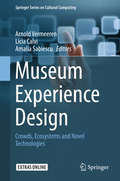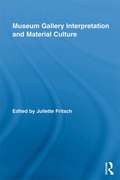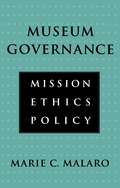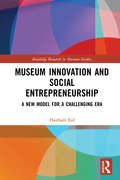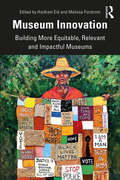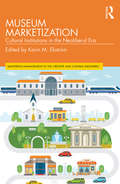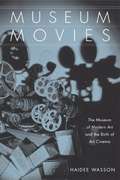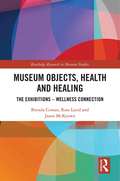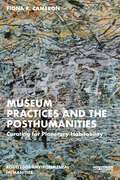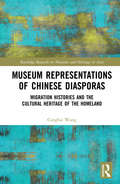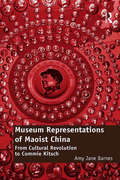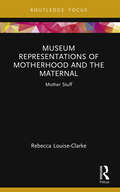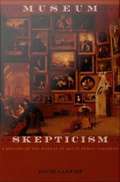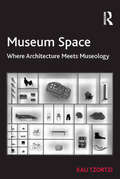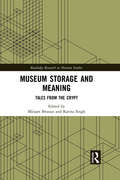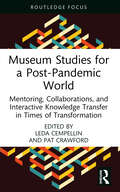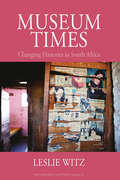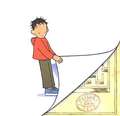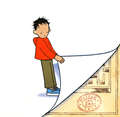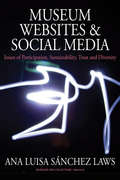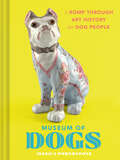- Table View
- List View
Museum Experience Design
by Arnold Vermeeren Licia Calvi Amalia SabiescuThis state-of-the-art book explores the implications of contemporary trends that are shaping the future of museum experiences. In four separate sections, it looks into how museums are developing dialogical relationships with their audiences, reaching out beyond their local communities to involve more diverse and broader audiences. It examines current practices in involving crowds, not as passive audiences but as active users, co-designers and co-creators; it looks critically and reflectively at the design implications raised by the application of novel technologies, and by museums becoming parts of connected museum systems and large institutional ecosystems. Overall, the book chapters deal with aspects such as sociality, creation and sharing as ways of enhancing dialogical engagement with museum collections. They address designing experiences – including participatory exhibits, crowd sourcing and crowd mining – that are meaningful and rewarding for all categories of audiences involved. Museum Experience Design reflects on different approaches to designing with novel technologies and discusses illustrative and diverse roles of technology, both in the design process as well as in the experiences designed through those processes. The trend of museums becoming embedded in ecosystems of organisations and people is dealt with in chapters that theoretically reflect on what it means to design for ecosystems, illustrated by design cases that exemplify practical and methodological issues in doing so. Written by an interdisciplinary group of design researchers, this book is an invaluable source of inspiration for researchers, students and professionals working in this dynamic field of designing experiences for and around museums.
Museum Gallery Interpretation and Material Culture: Museum Gallery Interpretation And Material Culture (Routledge Research in Museum Studies #2)
by Juliette FritschMuseum Gallery Interpretation and Material Culture publishes the proceedings of the first annual Sackler Centre for Arts Education conference at the Victoria and Albert Museum (V&A) in London. The conference launched the annual series by addressing the question of how gallery interpretation design and management can help museum visitors learn about art and material culture. The book features a range of papers by leading academics, museum learning professionals, graduate researchers and curators from Europe, the USA and Canada. The papers present diverse new research and practice in the field, and open up debate about the role, design and process of exhibition interpretation in museums, art galleries and historic sites. The authors represent both academics and practitioners, and are affiliated with high quality institutions of broad geographical scope. The result is a strong, consistent representation of current thinking across the theory, methodology and practice of interpretation design for learning in museums.
Museum Governance: Mission, Ethics, Policy
by Marie MalaroIn Museum Governance, Marie Malaro addresses a range of issues facing museum administrators and trustees, arguing they can handle their duties intelligently only if they understand two points--why our country sustains a nonprofit sector and what constitutes trusteeship. Armed with this knowledge, trustees can sort out knotty problems relating to corporate sponsorship, entrepreneurial activities, and fundraising in ways that preserve the integrity of the nonprofit.Malaro first explores the principles of nonprofit governance. She explains the purpose and use of professional codes of ethics and offers practical advice about board education and its role in fostering the long-term health of an organization. She then applies these principles to situations frequently confronting trustees, discussing how to set collection strategies, balance mission and entreprenurial ventures, handle deaccessioning, maintain effective board oversight, approach automation, and deal with repatriation requests.
Museum Innovation and Social Entrepreneurship: A New Model for a Challenging Era (Routledge Research in Museum Studies)
by Haitham EidMuseum Innovation and Social Entrepreneurship makes a contribution towards building a museum perspective of innovation that takes into consideration the unique role of museums in society. Beginning and ending with the idea of museum innovation in a wider sense, the book takes digital innovation as a particular focus. Drawing on innovation theories from business studies and case studies from national museums in the US and the UK, as well as numerous examples of innovative museum projects around the globe, the author unpacks, in practical terms, what it means for museums to be innovative and socially enterprising. As a result, Eid presents a research-based model of innovation in museums, which is flexible enough to be fully or partially adopted by any museum, regardless of size, location, mission or nature of the collections it houses. As such, this model makes innovation in museums scalable, replicable and feasible to start and operate. Supplying the museum studies field with essential terminologies and conceptual frameworks related to innovation, Museum Innovation and Social Entrepreneurship helps to forge new ideas and create common ground with other disciplines. Therefore, the book should be essential reading for academics, researchers and graduate students working in the fields of museum and heritage studies, digital humanities and business studies. It should also be of great interest to practitioners working in museums around the globe.
Museum Innovation: Building More Equitable, Relevant and Impactful Museums
by Haitham EidMuseum Innovation encourages museums to critically reflect upon current practices and adopt new approaches to their civic responsibilities. Arguing that museums have a moral duty to perform, the book shows how social innovation can make them more equitable, relevant and impactful institutions. Including contributions from a diverse group of international scholars, practitioners and researchers, the book investigates the innovative approaches museums are taking to address contemporary social issues. The volume focuses on the concept of social innovation and individual chapters address a range of crucial issues, such as climate change; the COVID-19 pandemic; diversity and inclusion; the travel ban; and the repatriation of museum collections. Exploring the impact that organizational structures have on museums’ aspirations to act as agents for social change, the book also unpacks how museums can establish sustainable relationships with minority communities. Proposing steps that museums can take to affirm their relevance as viable community partners, the book breaks down silos and connects ideas across different areas of museum work. Museum Innovation explores the role of contemporary museums in society. It is essential reading for academics, students and practitioners working in the museum and heritage studies field. The book’s interdisciplinary nature makes it also an interesting read for those working in business studies, digital humanities, visual culture, arts administration and political science fields.
Museum Marketization: Cultural Institutions in the Neoliberal Era (Mastering Management in the Creative and Cultural Industries)
by Karin M. EkströmThis wide-ranging book explores the impact of marketization on the creative industries. With critical perspectives from a variety of disciplines and global experts, numerous examples from international cultural institutions are employed to illuminate the topic. Culture and business have become increasingly intertwined, and cultural institutions need to be aware of their place in the market. Commercial awareness, which was previously disparaged, is now seen as a legitimate and necessary response to increased competition, enhancing experience, increasing accessibility, broadening inclusivity and sustainable futures with diminishing funding. The contributions to this book highlight that marketing, public relations, sponsorship and fundraising have become integral to the survival of many museums, galleries and events. Of interest to students and scholars across topics such as arts marketing, arts administration, heritage marketing and museum studies, the book is also insightful for reflective practitioners in the creative sector.
Museum Movies: The Museum of Modern Art and the Birth of Art Cinema
by Haidee WassonHaidee Wasson provides a rich cultural history of cinema's transformation from a passing amusement to an enduring art form by mapping the creation of the Film Library of the Museum of Modern Art (MoMA), New York, established in 1935. The film library pioneered an expansive moving image network, comprising popular, abstract, animated, American, Canadian, and European films.
Museum Objects, Health and Healing: The Relationship between Exhibitions and Wellness (Routledge Research in Museum Studies)
by Brenda Cowan Ross Laird Jason McKeownMuseum Objects, Health and Healing provides an innovative and interdisciplinary study of the relationship between objects, health and healing. Shedding light on the primacy of the human need for relationships with objects, the book explores what kind of implications these relationships might have on the exhibition experience. Merging museum and object studies, as well as psychotherapy and the psychology of well-being, the authors present a new theory entitled Psychotherapeutic Object Dynamics, which provides a cross- disciplinary study of the relationship between objects, health and well-being. Drawing on primary research in museums, psychotherapeutic settings and professional practice throughout the US, Canada, Bosnia-Herzegovina and the UK, the book provides an overview of the theory’s origins, the breadth of its practical applications on a global level, and a framework for further understanding the potency of objects in exhibitions and daily life. Museum Objects, Health and Healing will be essential reading for academics, researchers and postgraduate students interested in museum studies, material culture, mental health, psychotherapy, art therapies and anthropology. It should also be valuable reading for a wide range of practitioners, including curators, exhibition designers, psychologists, and psychotherapists.
Museum Practices and the Posthumanities: Curating for Planetary Habitability (Routledge Environmental Humanities)
by Fiona R. CameronThis book critiques modern museologies and curatorial practices that have been complicit in emerging existential crises. It confidently presents novel, more-than-human curatorial visions, methods, frameworks, policies, and museologies radically refiguring the epistemological foundations of curatorial, museological thinking, and practice for a habitable planet. Modern curatorial and museological practices are dominated by modern humanism in which capital growth, social, technological advancement, hubris, extraction, speciest logics, and colonial domination predominate, often without reflection. While history, science, and technology museums and their engagement with non-human worlds have always been ecological as an empirical reality, the human-centred frameworks and forms of human agency that institutions deploy tend to be non-cognizant of this reality. Museum Practices and the Posthumanities: Curating for Planetary Habitability reveals how these practices are ill-equipped to deal with the contemporary world of rapid digital transformations, post-Covid living, climate change, and its impacts among other societal changes, and it shows how museums might best meet these challenges by thinking with and in more-than-human worlds. This book is aimed at museological scholars and museum professionals, and it will provide them with the inspiration to conduct research on and curate from a different ecological reference point to promote a world good enough for all things to thrive in radical co-existence.
Museum Representations of Chinese Diasporas: Migration Histories and the Cultural Heritage of the Homeland (Routledge Research on Museums and Heritage in Asia)
by Cangbai WangMuseum Representations of Chinese Diasporas is the first book to analyse the recent upsurge in museums on Chinese diasporas in China. Examining heritage-making beyond the nation state, the book provides a much-needed, critical examination of China’s engagement with its diasporic communities. Drawing on fieldwork in more than ten museums, as well as interviews with museum practitioners and archival study, Wang offers a timely analysis of the complex ways in which Chinese diasporas are represented in the museum space of China, the ancestral homeland. Arguing that diasporic heritage is highly ambivalent and introducing a diasporic perspective to the study of cultural heritage, this book opens up a new avenue of inquiry into the study and management of cultural heritage in China and beyond. Most importantly, perhaps, Wang sheds new light on the dynamic between China and Chinese diasporas through the lens of the museum. Museum Representations of Chinese Diasporas takes a transnational perspective that will draw attention to the under-researched connections between heritage, mobility and meaning in a global context. As such, this cross-disciplinary work will be of interest to scholars and students working in the museum and heritage studies fields, as well as those studying Asia, China, migration and diaspora, anthropology, history and culture.
Museum Representations of Maoist China: From Cultural Revolution to Commie Kitsch
by Amy Jane BarnesThe collection, interpretation and display of art from the People’s Republic of China, and particularly the art of the Cultural Revolution, have been problematic for museums. These objects challenge our perception of ’Chineseness’ and their style, content and the means of their production question accepted notions of how we perceive art. This book links art history, museology and visual culture studies to examine how museums have attempted to reveal, discuss and resolve some of these issues. Amy Jane Barnes addresses a series of related issues associated with collection and display: how museums deal with difficult and controversial subjects; the role they play in mediating between the object and the audience; the role of the Other in the creation of Self and national identities; the nature, role and function of art in society; the museum as image-maker; the impact of communism (and Maoism) on the cultural history of the twentieth-century; and the appropriation of communist visual iconography. This book will be of interest to researchers and students of museology, visual and cultural studies as well as scholars of Chinese and revolutionary art.
Museum Representations of Motherhood and the Maternal: Mother Stuff (Museums in Focus)
by Rebecca Louise-ClarkeMuseum Representations of Motherhood and the Maternal is the first book to address the underrepresentation of motherhood in museums. Questioning how mothering and maternal experiences should be represented in museums, Louise-Clarke argues that such institutions wield the power to influence what we think about families, mothers and the labour of care. Using the term ‘mothering’ to encompass lived experiences of mothering or caring that are not exclusively tied to sex, gender, or the maternal body, Louise-Clarke explores the ways that experiences of mothering can be represented in museums. The book begins this exploration with Australia’s Museums Victoria (MV), then expands to look at international cases. Offering a blueprint for what Louise-Clarke calls a ‘museology of mothering’, the book imagines what a museum that articulates maternal subjectivities might look and sound like. Museum Representations of Motherhood and the Maternal initiates a dialogue between museum studies and maternal studies, making it essential reading for scholars and students working in both disciplines. Questioning conventional museum practices and the values that underpin them, the book will also be of interest to museum and heritage practitioners around the world.
Museum Skepticism: A History of the Display of Art in Public Galleries
by David CarrierIn Museum Skepticism, art historian David Carrier traces the birth, evolution, and decline of the public art museum as an institution meant to spark democratic debate and discussion. Carrier contends that since the inception of the public art museum during the French Revolution, its development has depended on growth: on the expansion of collections, particularly to include works representing non-European cultures, and on the proliferation of art museums around the globe. Arguing that this expansionist project has peaked, he asserts that art museums must now find new ways of making high art relevant to contemporary lives. Ideas and inspiration may be found, he suggests, in mass entertainment such as popular music and movies. Carrier illuminates the public role of art museums by describing the ways they influence how art is seen: through their architecture, their collections, the narratives they offer museum visitors. He insists that an understanding of the art museum must take into account the roles of collectors, curators, and museum architects. Toward that end, he offers a series of case studies, showing how particular museums and their collections evolved. Among those who figure prominently are Baron Dominique Vivant Denon, the first director of the Louvre; Bernard Berenson, whose connoisseurship helped Isabella Stewart Gardner found her museum in Boston; Ernest Fenollosa, who assembled much of the Asian art collection now in the Museum of Fine Arts, Boston; Albert Barnes, the distinguished collector of modernist painting; and Richard Meier, architect of the J. Paul Getty Center in Los Angeles. Carrier's learned consideration of what the art museum is and has been provides the basis for understanding the radical transformation of its public role now under way.
Museum Space: Where Architecture Meets Museology
by Kali TzortziMuseums are among the iconic buildings of the twenty-first century, as remarkable for their architectural diversity as for the variety of collections they display. But how does the architecture of museums affect our experience as visitors? This book proposes that by seeing space as common ground between architecture and museology, and so between the museum building and its display, we can illuminate the individuality of each museum and the distinctive experience it offers - for example, how some museums create a sense of personal exploration, while others are more intensely didactic, and how the visit in some cases is transformed into a spatial experience and in other cases into a more social event. The book starts with an overview of the history of museum buildings and display strategies, and a discussion of theoretical and critical approaches. It then focuses on specific museums as in-depth case studies, and uses methods of spatial analysis to look at the key design choices available to architects and curators, and their effects on visitors’ behaviour. Theoretically grounded, methodologically original, and richly illustrated, this book will equip students, researchers and professionals in the fields of architecture, museum studies, curating, exhibition design, and cultural studies, with a guide for studying museums and a theoretical framework for their interpretation.
Museum Storage and Meaning: Tales from the Crypt (Routledge Research in Museum Studies)
by Mirjam Brusius Kavita SinghBeyond their often beautiful exhibition halls, many museums contain vast, hidden spaces in which objects may be stored, conserved, or processed. Museums can also include unseen archives, study rooms, and libraries which are inaccessible to the public. This collection of essays focuses on this domain, an area that has hitherto received little attention. Divided into four sections, the book critically examines the physical space of museum storage areas, the fluctuating historical fortunes of exhibits, the growing phenomenon of publicly visible storage, and the politics of objects deemed worthy of collection but unsuitable for display. In doing so, it explores issues including the relationship between storage and canonization, the politics of collecting, the use of museum storage as a form of censorship, the architectural character of storage space, and the economic and epistemic value of museum objects. Essay contributions come from a broad combination of museum directors, curators, archaeologists, historians, and other academics.
Museum Studies for a Post-Pandemic World: Mentoring, Collaborations, and Interactive Knowledge Transfer in Times of Transformation
by Leda Cempellin and Pat CrawfordMuseum Studies for a Post-Pandemic World demonstrates that digital literacy, creativity, and resilience, as the COVID-19 pandemic has so vividly illustrated, are now vital components of the classroom and of the curator’s toolbox.Museum studies students are increasingly asked to engage with new team dynamics and collaborative models, often relocated to the virtual world. Authored by academics, cultural heritage partners, students, and alumni, the chapters in this volume move beyond a consideration of the impact of digitisation to envision new strategies and pedagogies for fuller, more sustainable approaches to cultural literacy, exhibition, and visitor engagement. International case studies present models of collaborative practices between teams of diverse sizes and professional backgrounds. The volume demonstrates that the COVID-19 pandemic has forced the use of a variety of pedagogically and culturally significant hybrid and virtual models that provide innovative learning modalities to meet the needs of future generations of digital native patrons. This book offers meaningful strategies that will help academic and cultural heritage institutions engaged in museum studies to survive — and even thrive — in the face of future disasters by expanding programme accessibility beyond the physical confines of their buildings.Museum Studies for a Post-Pandemic World will be of interest to students and researchers engaged in the study of museums, the arts, cultural management, and education. It should also be of interest to museum practitioners around the world.
Museum Times: Changing Histories in South Africa (Museums and Collections #16)
by Leslie WitzMuseums flourished in post-apartheid South Africa. In older museums, there were renovations on the go, and at least fifty new museums opened. Most sought to depict violence and suffering under apartheid and the growth of resistance. These unlikely journeys are tracked as museums became a primary setting for contesting histories. From the renowned Robben Island Museum to the almost unknown Lwandle Migrant Labour Museum, the author demonstrates how an institution concerned with the conservation of the past is simultaneously a site for changing history.
Museum Trip
by Barbara LehmanMuseums: filled with mysterious, magical art and curiosities? Or secrets? And what might happen if a boy suddenly became part of one of the mind-bending exhibits? Join the fun in Museum Trip, by Barbara Lehman, the author-illustrator of the Caldecott Honor-winning The Red Book.
Museum Trip
by Barbara LehmanMuseums: filled with mysterious, magical art and curiosities? Or secrets? And what might happen if a boy suddenly became part of one of the mind-bending exhibits? Join the fun in Museum Trip, by Barbara Lehman, the author-illustrator of the Caldecott Honor–winning The Red Book.
Museum Websites and Social Media: Issues of Participation, Sustainability, Trust and Diversity (Museums and Collections #8)
by Ana Sánchez LawsOnline activities present a unique challenge for museums as they harness the potential of digital technology for sustainable development, trust building, and representations of diversity. This volume offers a holistic picture of museum online activities that can serve as a starting point for cross-disciplinary discussion. It is a resource for museum staff, students, designers, and researchers working at the intersection of cultural institutions and digital technologies. The aim is to provide insight into the issues behind designing and implementing web pages and social media to serve the broadest range of museum stakeholders.
Museum of Dogs: A Romp through Art History for Dog People
by Jessica PoundstoneJourney into your own pocket-sized museum, filled with a collection of charming art-historical pups! Ready to meet a pack of very good dogs immortalized in painting and sculpture? This quirky and fascinating little book collects the best canines in art history, including:Rustic figurines carved in ancient GreeceElegant porcelain pooches handcrafted in 19th-century RussiaA tiny Japanese netsuke in the shape of a puppyA portrait of a spaniel woven by a beadwork artisan in MexicoAnd so much more!Artist and writer Jessica Poundstone has scoured the world's museum collections for these hidden treasures and offers fun and informative commentary on each. Her bite-sized text gives historical context and celebrates each dog’s sweet, noble, or wacky personality, which transcends history to hit us right in the feels. This delightful volume offers pure delight for dog lovers and art lovers alike.PERFECTLY GIFTABLE: This is a charming gift for people who love art and dogs! A petite and beautifully designed hardcover book, it makes an entertaining and educational present for friends and family or a treat for yourself. It's simply impawsible to resist.CURATED COLLECTION: Flipping through this art book is like getting a special guided tour of a wondrous museum devoted entirely to our furry friends. In a world of sensory overload, it offers a wonderful way to tap into the joy of something curated just for you. FUN ANGLE ON FINE ART: Whether you are a devoted museumgoer or casually art-curious, this book offers a unique and delightful spin on art history. The content covers a wide range of styles, media, and eras, creating a perfect opportunity to brush up on your art IQ with the help of man's best friend.Perfect for:Animal loversArt and art history buffsGift-giving to dog owners, artists, and collectorsFans of art/humor crossovers like Men to Avoid in Art and Life and William Wegman: Being HumanFans of clever art history like Art Dog and A History of Art in 21 Cats
Museum of the American Railroad (Images of Modern America)
by Museum of the American RailroadEstablishing its collection as the Age of Steam exhibit at Dallas's Fair Park in 1963, the Museum of the American Railroad would go on to acquire over 45 locomotives and railcars. By 2006, the museum needed to move from its first home to a larger facility to allow more space to exhibit the collection of railcars, documents, and other artifacts. One of the keystone pieces is the GG-1 electric locomotive that pulled Robert Kennedy's funeral train in 1968. It has been restored to its original Pennsylvania Railroad appearance. The museum also houses the Centennial--the world's largest diesel-electric locomotive--as well as the rare and famous Santa Fe Alco PA-1 locomotive, acquired from the Smithsonian Institution.
Museum, Place, Architecture and Narrative: Nordic Maritime Museums’ Portrayals of Shipping, Seafarers and Maritime Communities (Museums and Collections #15)
by Annika BünzA characteristic trait of the maritime museums is that they are often located in a contemporary and/or historical environment from which the collections and narratives originate. The museum can thereby be directly linked to the site and its history. It is therefore vital to investigate the maritime museums in terms of relationships between landscape, architecture, museum and collections. This volume unravels the kinds of worlds and realities the Nordic maritime museums stage, which identities and national myths they depict, and how they make use of both the surrounding maritime environments and the architectural properties of the museum buildings.
Museum-Making in Vietnam, Laos, and Cambodia: Cultural Institutions and Policies from Colonial to Post-Colonial Times
by Jonathan PaquetteBuilding on archival work undertaken in France and fieldwork undertaken in Southeast Asia, Museum-Making in Vietnam, Laos, and Cambodia provides a critical analysis of museum histories and development in three former colonial territories. This work documents the development of museums in French Indochina (1862-1954), specifically Vietnam, Laos, and Cambodia. The book explores the colonial culture of exhibition, traces the growth of museum collections through archaeological missions to Indochina and other parts of Asia, and examines the role of museums in the cultural life of this colonial society. In particular, the author re-contextualizes the role and part played by colonial museums in the implementation of heritage policies during the colonial era in French Indochina, a dimension that is often overlooked. Additionally, the book addresses the effects that the Second World War, the Vichy Regime, and the Japanese occupation had on these cultural institutions. The transformation of these museums in post-independence Vietnam, Laos, and Cambodia is also discussed. Providing comparisons with other colonial and post-colonial experiences, Museum-Making in Vietnam, Laos, and Cambodia will be a valuable resource for researchers in museum and heritage studies. It will also appeal to researchers and graduate students engaged in the study of history, anthropology, sociology, political science, and development and international studies.
Museums Inside Out: Artist Collaborations and New Exhibition Ecologies
by Mark W. RectanusAn ambitious study of what it means to be a museum in the twenty-first century In Museums Inside Out, Mark W. Rectanus investigates how museums are blurring the boundaries between their gallery walls and public spaces. He examines how artists are challenging and changing museums, taking readers deep into new experiments in exhibition making. Along the way, Rectanus offers insights about how museums currently exemplify the fusion of the creative and digital economies. Exploring contemporary museum practices, initiatives, and collaborations, Rectanus analyzes projects like the Collective Museum, which foster land-based museum ecologies by co-curating with local communities. The Schirn Kunsthalle, Petach Tikva Museum of Art, and Tate Modern reflect museums as cultural zones for performance, inside and outside the museum. In addition, he studies a joint project between the Van Gogh Museum and the investment firm Deloitte Luxembourg, extracting insights on the transfer of expertise from museums to the financial sector. Wide-ranging in its case studies, and boldly putting museum studies and art into conversation, Museums Inside Out delivers vital insights into the ideas and places that museums are creating in contemporary culture.
